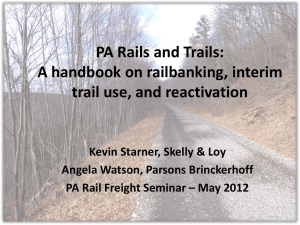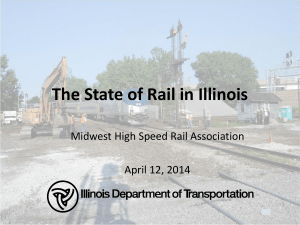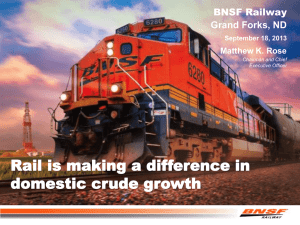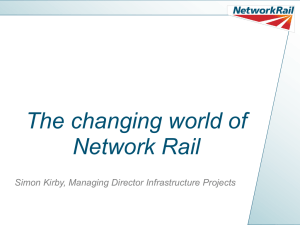CSX/Conrail - AASHTO - Standing Committee on Rail
advertisement
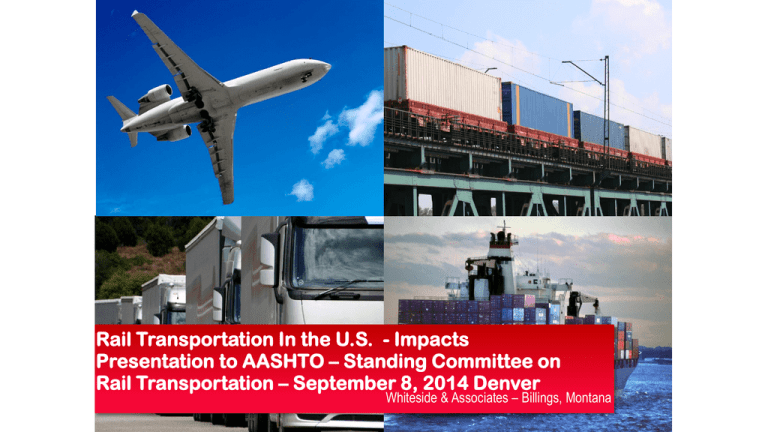
Rail Transportation In the U.S. - Impacts Presentation to AASHTO – Standing Committee on Rail Transportation – September 8, 2014 Denver Whiteside & Associates – Billings, Montana Four Briefing Items 1. 2. 3. 4. U.S. Rail Maps and Rail Concentration Rail Captivity and its effects on State and their economies Coal/Oil/Intermodal – Growth Traffic - Movements on Rail Role of Communities/Government in assisting with upcoming impacts of increasing rail traffic B N S F U P The Big Four Control Over 95% of all Ton-Miles Hauled N S C S X Burlington Northern/Santa Fe UPSP CSX/Conrail Norfolk Southern/Conrail Did HASBRO, in 1935, Get It Right About Railroads? They said, “if you own all four of the railroads….you are allowed to charge 8 times the rates that you can charge if you only own one railroad”! The Union Pacific ‘Opoly’ Game Is On The Shelves!!!! •The UP became the UP of today by buying the Southern Pacific, the KATY, the Missouri Pacific, The Denver & Rio Grande, the Chicago Northwestern, and the Western Pacific….. •On the Denver & Rio Grande card it states: Rent = 4 times the amount show on the dice, 10 times amount shown on the dice if both “Western Pacific” and “Denver & Rio Grande” are owned!!!!!!!! (see lower right hand corner) If the UP gets it, why not everyone? WHAT IS THE CAPTIVE SHIPPER RAILROAD PROBLEM IN U.S.? 1. Combination of ineffective regulation and ineffective competition 2. Monopoly railroads control essential facilities of commerce 3. Railroad negotiating position is too often “Take it or leave it” or even “No, we won’t allow that” 4. STB rail regulation is too expensive, too slow and too rarely actually helps. Railroads are not penalized when they act unlawfully. At most, they are merely required to undo the damage they caused (e.g., refund excess rates after the rare successful shipper rate challenge) 5. In U.S., rail short lines are neutralized and antitrust laws are largely inapplicable due to erroneous assumption of effective regulation Times and Markets Have Changed; Policies Have Not 1980: Policy Goals 2014: Time to Reassess Strengthen Railroad Finances Railroads are Financially Sustainable Provide Quick Dispute Resolutions Disputes Costly and Time Consuming Ensure Effective Competition Wherever Possible Policies Prevent Shippers from Competitive Access and Reasonable Rates Maintain Reasonable Rates Even Without Effective Competition Rail Mergers Significantly Reduced Competition and Rates Soared “The goal of the Staggers Acts was not to enrich railroad companies, but to ‘provide a regulatory process that balances the needs of carriers, shippers, and the public.’ [Policymakers] will need to carefully consider whether changes are needed to reach this goal.” - Senate Committee on Commerce, Science, and Transportation; 2013 Most Shippers Lack Competitive Rail Service 78% of freight rail stations are captive by a single Class I railroad. In every state, the majority of rail stations are now captive to a Class I railroad. Source: Analysis of Freight Rail Rates for Chemical Shippers; Escalation Consultants; 2012 How Rail Rates Are Measured by The Surface Transportation Board (STB) • There are two components of any cost – fixed and variable • STB for regulatory purposed measures and models RR Variable Costs based upon an allocation model called the Uniform Rail Costing System (URCS) • To measure relative profitability – a ratio of Revenue/Variable Cost (called RVC) of a movement is developed 100% RVC is exactly what you would think – those 100% of costs that vary with output 120-140% RVC is where most economists believe are the full cost of railroad for its operations < 180% RVC – the STB does not have jurisdiction to adjudicate the fairness of a rail rate >180% RVC is the Congressionally mandated threshold where the STB can adjudicate the fairness of a rail rate the degree to which a rate is above 180% is the degree of ‘Premium’ the railroad is exacting from the movement Revenue to Variable Cost - Rail Wheat Shipments BNSF and UP to Mexico Crossovers, Gulf and PNW - January 2014 360% Revenue to Variable Cost (URCS) in % 351% 332% 308% 319% 303% 292% 274% 303% 308% 306% 278% 239% 225% 260% 251% 216% 180% RVC - Threshold of Unreasonable Challenge Origin 205% Revenue to Variable Cost - Rail Wheat Shipments to Gulf BNSF and UP - March 2014 Revenue to Variable Cost (URCS) in % Rates to Gulf on Wheat (BNSF and UP) Are Well-above the Threshold of Unreasonableness 490% 436% 333% 293% 305% 281% 272% 269% 245% 180% of Variable Threshold of Unreasonable Challenge Origin Whiteside & Associates Billings, MT March 2014, email: twhitesd@wtp.net Two Avenues to Address High Rate Structures 1.The Surface Transportation Board adjudicates railroad rate and service railroad cases • The Alliance for Rail Competition and individual states (Commissions, Committees, Attorney Generals, etc.) can and do participate in STB cases or at the STB bar on behalf of the growers, merchandisers and their constituents 2.To change policy at the STB, requires legislative action • There is a Rail Customer Coalition operating in DC of which the Alliance for Rail Competition, NAWG and the ACC together with other groups, actively participating and working to educate policymakers about the rail shipper problems and regulatory/competition issues What I Worry About Re: Future Rail Mergers • The “final solution” – i.e., east-west trans-con mergers (e.g., BN-NS and UP-CSXT or BN-CSXT and UP-NS). • UP and CSXT cannot sustain billion dollar losses per year from the reduction in coal traffic. They will look to merge to create synergies (e.g., more efficient and less costly intermodal traffic) to help off-set these losses. • Big Hurdles to accomplish this – may occur with working agreements first • Result: Duopoly over the whole country 4/19/13 4/24/13 4/29/13 5/4/13 5/9/13 5/14/13 5/19/13 5/24/13 5/29/13 6/3/13 6/8/13 6/13/13 6/18/13 6/23/13 6/28/13 7/3/13 7/8/13 7/13/13 7/18/13 7/23/13 7/28/13 8/2/13 8/7/13 8/12/13 8/17/13 8/22/13 8/27/13 9/1/13 9/6/13 9/11/13 9/16/13 9/21/13 9/26/13 10/1/13 10/6/13 10/11/13 10/16/13 10/21/13 10/26/13 10/31/13 11/5/13 11/10/13 11/15/13 11/20/13 11/25/13 11/30/13 12/5/13 12/10/13 12/15/13 12/20/13 12/25/13 12/30/13 1/4/14 1/9/14 1/14/14 1/19/14 1/24/14 1/29/14 2/3/14 2/8/14 2/13/14 2/18/14 2/23/14 2/28/14 3/5/14 3/10/14 3/15/14 3/20/14 3/25/14 3/30/14 4/4/14 4/9/14 4/14/14 4/19/14 4/24/14 4/29/14 5/4/14 5/9/14 5/14/14 5/19/14 5/24/14 5/29/14 6/3/14 6/8/14 6/13/14 6/18/14 6/23/14 6/28/14 7/3/14 7/8/14 7/13/14 7/18/14 7/23/14 7/28/14 8/2/14 8/7/14 8/12/14 8/17/14 8/22/14 BNSF AVERAGE TRAIN SPEED IN MPH Chart II – BNSF Systemwide Average Train Speed – System and Grain BNSF Systemwide Average Train Speed - Grain Vs System 25 24 Train Speeds (all) Train Speeds (grain) 23 22 21 20 19 18 Source: American Association of Railroads Whiteside & Associates Billings, Montana 08/28/2014 Email: twhitesd@wtp.net 17 Increasing Coal, Oil and Intermodal Spell Capacity Problems Poor Service = Tighter Capacity = Higher Prices for Traditional Commodities Figure 23 from HTSA, February 2014 North Dakota Crude Oil Production BNSF ORIGINATED CARLOADS PER QUARTER OF CORN, WHEAT & SOYBEANS VS. OIL & SAND 160,000 140,000 120,000 BNSF Carloads 100,000 Corn, Wheat & Soybeans 80,000 Oil & Sand Linear (Corn, Wheat & Soybeans) Linear (Oil & Sand) 60,000 40,000 20,000 0 2Q 2011 3Q 2011 4Q 2011 1Q 2012 2Q 2012 3Q 2012 4Q 2012 Date by Quarter 1Q 2013 2Q 2013 3Q 2013 4Q 2013 1Q 2014 23 Chart IV BNSF Originated Carloads Per Quarter of Wheat Compared to Oil and Sand BNSF ORIGINATED CARLOADS PER QUARTER OF WHEAT VS. OIL & SAND 120,000 100,000 BNSF Carloads 80,000 Wheat 60,000 Oil Linear (Wheat) Linear (Oil) 40,000 20,000 0 2Q 2011 3Q 2011 4Q 2011 1Q 2012 2Q 2012 3Q 2012 4Q 2012 1Q 2013 2Q 2013 3Q 2013 4Q 2013 1Q 2014 Date by Quarter 24 The Decline in Coal Movement and the BNSF shift to Westbound Export Coal + Oil – Impact on Grain Rates The decline in coal movements and the shift to potential export movements is important to and for grain shippers for several reasons: • Domestic grain rates will likely increase, especially on CSX, NS and UP • Capacity for export grain transportation will tighten as RR’s export coal and Bakken oil shipments increase and, as a result, RR’s export grain rates will increase. There will also be an impact on revenue adequacy. Five RR’s are now Revenue Adequate Table II Recent Increases in BNSF Grain Rates Per Ton Carried Poor Service = Tighter Capacity = Higher Prices The Danger is Ever Present All Oil Fires in Past 2 Years Bakken Oil What Can The Communities/Government Do To Provide Mitigation/Planning? Conclusion & Recommendations • This is not a time for panic for Communities – but it is a time for conversations to be initiated among all of the stakeholders • RR’s continue to state publicly that estimated coal numbers are not realistic while confirming that at “50 to 100 Million tons” are on track to move to “2 or 3 terminals.” • ‘Don’t concern yourself professed by some of the railroads’ is not a strategy that will produce solutions • ‘Let the process work professed by some of the railroads’ – fact: there is no process to involve or protect stakeholders • Not all coal, intermodal, oil volumes will come to fruition – but in the PNW for example, in Longview and Cherry Point and BC Roberts Banks – most advanced are on track to move over 110 million tons/year. FACT: Not all terminals will NOT be built but the danger to communities of transporting hazardous loads by rail will present challenges • Work together with cities, towns, railroads, environmental organizations, assessing environmental impacts, coal companies, associations, commissions and state, federal and Congressional reps makes sense • Looking forward – the path towards solutions requires engagement of all parties and developing conversations and concerns • Example: The Northern Tier of the BNSF is suffering the worst service meltdown in modern history – started with increasing coal and oil shipments in 2012 • Cities and communities need to develop data or what impacts/solutions they need • State DOT’s need to be pro-active with communities, transportation providers to help develop solutions and collaboration to mitigate expected impacts

